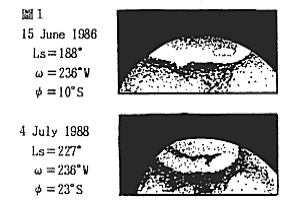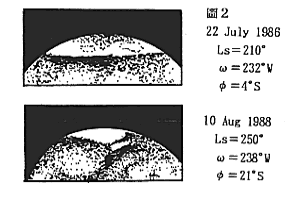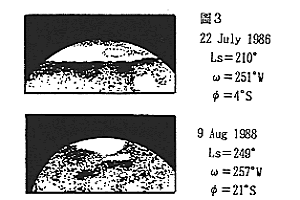Great 2003 Mars Coming (07)
Great 2003 Mars Coming
(7)
Watch the Inside of the South Polar Cap
M MINAMI
In 2001, it was rather impossible to watch the shadowy variation of the inside of the south polar cap ( spc ) because the tilt φ of the north pole was not away but lingered near on the equator. On the other hand it will however be easier in 2003 to watch the whole of the spc in details since the φ points down to the southern hemisphere.
We here so give a time schedule of several possible phenomena to observe as a function of the season λ (given by Ls).
At λ =180°Ls (on 5 May 2003), the spc will be more apparent, but we should begin to watch much before that. In Mn's experience in 1986 (at Taipei), the inside of the spc / sph appeared already not uniform in brightness at λ =176°Ls (on 24 May 1986) and the periphery looked brighter (note that the φ was 11°S in 1986, while it was 3°N in 2001 and so large difference). In 2003, the season will come around 28 April 2003 (with φ =16°S). As noted several times, λ =176°Ls is a milestone as VO2 gave the first data in its extended mission.
In 1986, at λ =180°Ls the light and shade inside the spc was evident though still φ =10°S. In 2003, λ =180°Ls will be attained at φ = 17°S. It looks so advantageous, but δ =9.8" in 2003 while δ =17.1" in 1986, and so we need a good seeing this time. In 1988, δ =7.6" at the season, and so no results.
At λ =185°Ls, the centre of the spc must be shadowy because the pole receives the sunbeams whole day. In 1988, the phenomenon was checked after λ =190°Ls when δ =8.7". In 2003, λ =190°Ls (on 21 May 2003) visits when δ = 11.2" as well as φ =19°S and hence it is more advantageous.
The Next Step: The present writer well remembers that he noticed in 1988 a very clear rift inside the spc as soon as he moved to Taipei, Taiwan to observe (second expedition to the Taipei City Observatory with a GOTO 25 cm refractor). It was on 3 June 1988 and the season was λ =208°Ls while φ =23°S and δ =10.5". In 2003, λ =208°Ls will come on 22 June 2003 with φ =21°S and δ =15.2", and so we expect we will be able to catch the rift much earlier in 2003. If we pick out the time when δ =10.5", it corresponds to mid-May 2003 around λ =185°Ls. Note however unfortunately we will meet the rainy season in Japan. Visually we should be attentive about the length and the direction of the rift. By means of the ccd, the exposure time with respect to IR should be very appropriate.
The rift and shadow in a full spc will be always apparent from λ =220°Ls to 230°Ls, and so we should record the variation of the melting process. This is indispensable to the check of the asymmetrical thawing of the spc following the season. It is necessary to chase the direction of the rifts every forty minutes. The season λ =210°Ls comes on 26 June 2003 with δ =15.9" and φ = 21°S, and the season λ =230°Ls is on 28 July 2003 with δ =22.4" and φ =20°S, and so the condition is satisfactory. If we will not meet with any typhoon, the observations in the Okinawa islands will be perfect. The rainy or overcast sky will not necessarily be over in the main land however.
After λ =230°Ls (on 28 July 2003), the thawing of the spc becomes asymmetrical and the centre of the spc will move to the direction of 030°W, and so the opposite side (centred at 210°W) as well as their quarters should be more watched. As to the deviation of the spc centre, see articles in CMO #007 and #240. The season λ =240°Ls will reach on 13 August 2003. The planet will be soon at opposition, and so no inattentive observations may be possible.
We close by pointing out that not only the shadowy areas are observable, but several bright spots inside the spc are to be checked. As to the 1988 results, NAKAJIMA and Mn gave a review in 1988 CMO Note (18) published in CMO #115 p1004 which shows about the early detection of Novus Mons since AONTONIADI (Mountains of Mitchel since 1845) in addition to the shadowy areas as described above.
fig 1
 Figure 1 there shows Novus Mons not yet detached from the spc at λ =227°Ls: it was observed when δ =13.5" at ω =236°W. Every figure is composed of two scenes to compare, and the other one in Fig 1 shows a larger spc observed by Mn at λ =188°Ls in 1986 at the same angle ω =236°W: It shows a bright area inside the spc and is considered to correspond to Novus Mons. In 2003, the apparent diameter δ is just 11.2" at λ =188°Ls, and so we will not be able to detect the bright spot, but before λ =227°Ls (on 24 July 2003 when δ =20.9") we will meet several opportunities to detect the still-inside-staying Novus Mons.
Figure 1 there shows Novus Mons not yet detached from the spc at λ =227°Ls: it was observed when δ =13.5" at ω =236°W. Every figure is composed of two scenes to compare, and the other one in Fig 1 shows a larger spc observed by Mn at λ =188°Ls in 1986 at the same angle ω =236°W: It shows a bright area inside the spc and is considered to correspond to Novus Mons. In 2003, the apparent diameter δ is just 11.2" at λ =188°Ls, and so we will not be able to detect the bright spot, but before λ =227°Ls (on 24 July 2003 when δ =20.9") we will meet several opportunities to detect the still-inside-staying Novus Mons.
fig 2 
 fig 3
Figures 2 and 3 show the comparisons of the spc when λ =210°Ls and λ =240°Ls (or 250°Ls): any of the latter shows the detached Novus Mons. The planet will be closest to us when λ =249°Ls, and so it will be quite easy to detect the detached Novus Mons in August and September.
fig 3
Figures 2 and 3 show the comparisons of the spc when λ =210°Ls and λ =240°Ls (or 250°Ls): any of the latter shows the detached Novus Mons. The planet will be closest to us when λ =249°Ls, and so it will be quite easy to detect the detached Novus Mons in August and September.
Back to CMO #268 Home Page
Back to the CMO HP / Back to the Façade
 Figure 1 there shows Novus Mons not yet detached from the spc at λ =227°Ls: it was observed when δ =13.5" at ω =236°W. Every figure is composed of two scenes to compare, and the other one in Fig 1 shows a larger spc observed by Mn at λ =188°Ls in 1986 at the same angle ω =236°W: It shows a bright area inside the spc and is considered to correspond to Novus Mons. In 2003, the apparent diameter δ is just 11.2" at λ =188°Ls, and so we will not be able to detect the bright spot, but before λ =227°Ls (on 24 July 2003 when δ =20.9") we will meet several opportunities to detect the still-inside-staying Novus Mons.
Figure 1 there shows Novus Mons not yet detached from the spc at λ =227°Ls: it was observed when δ =13.5" at ω =236°W. Every figure is composed of two scenes to compare, and the other one in Fig 1 shows a larger spc observed by Mn at λ =188°Ls in 1986 at the same angle ω =236°W: It shows a bright area inside the spc and is considered to correspond to Novus Mons. In 2003, the apparent diameter δ is just 11.2" at λ =188°Ls, and so we will not be able to detect the bright spot, but before λ =227°Ls (on 24 July 2003 when δ =20.9") we will meet several opportunities to detect the still-inside-staying Novus Mons.
 fig 3
fig 3